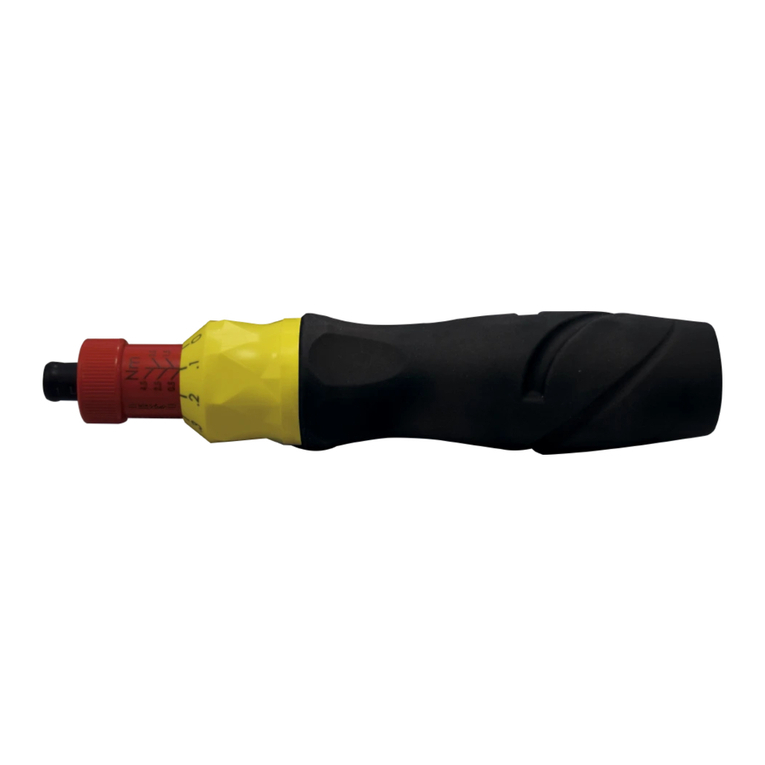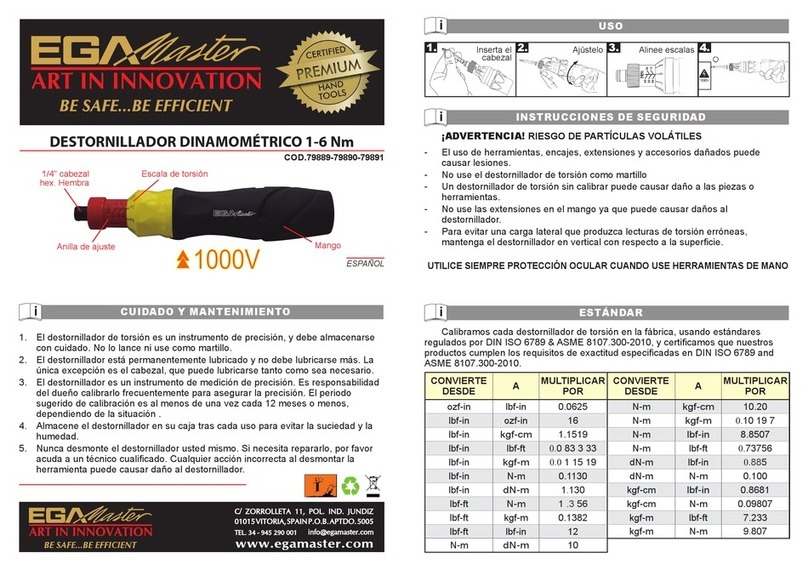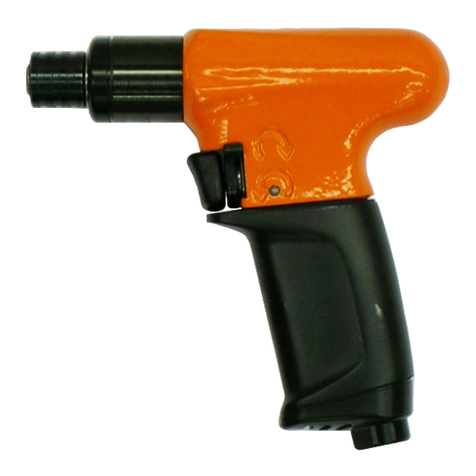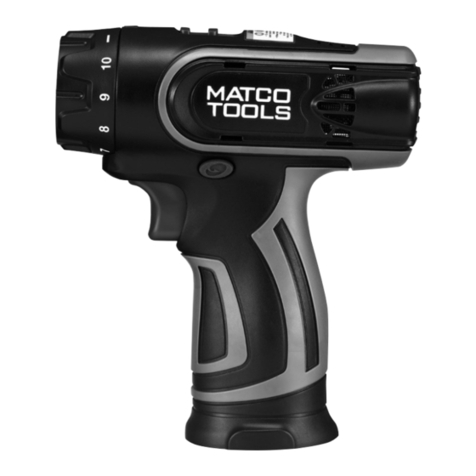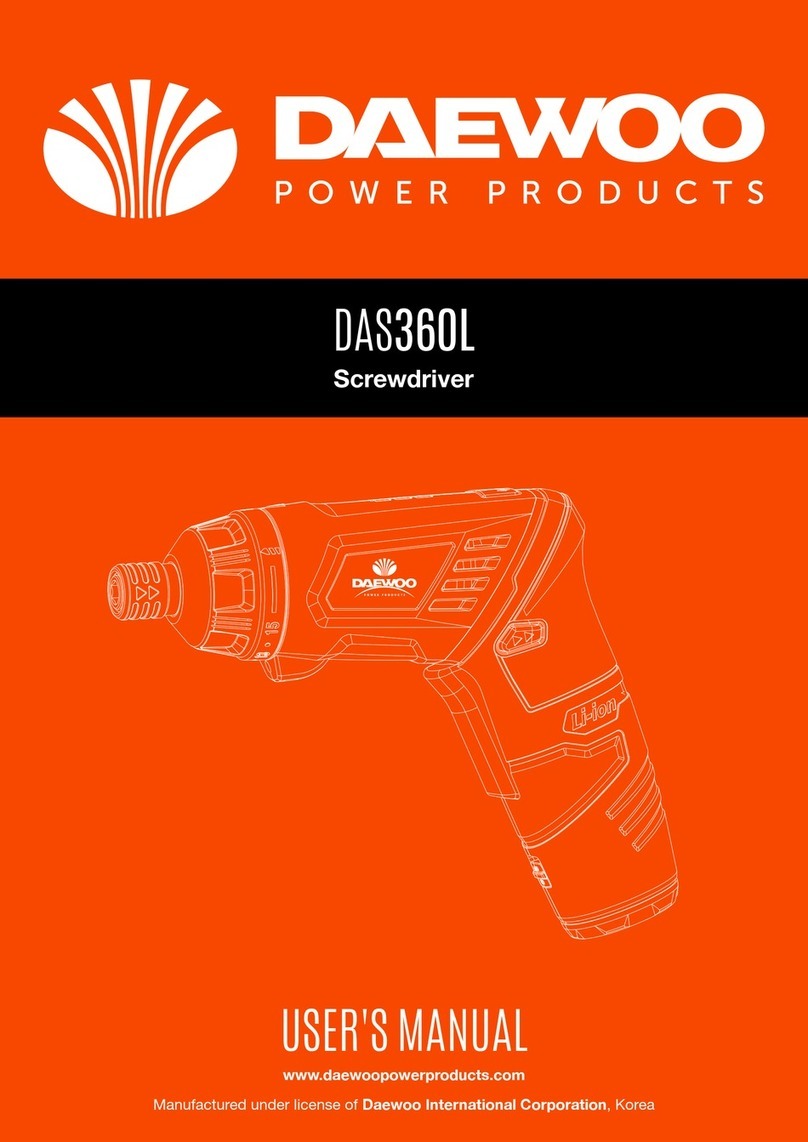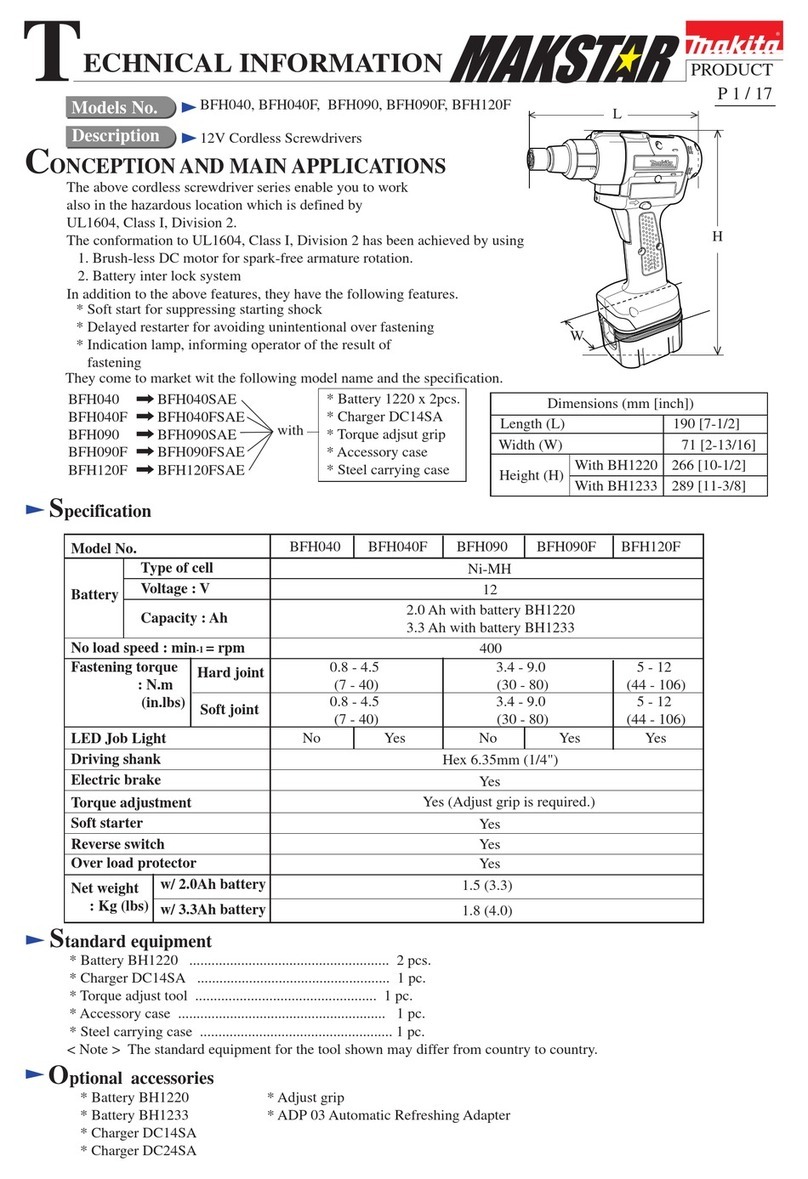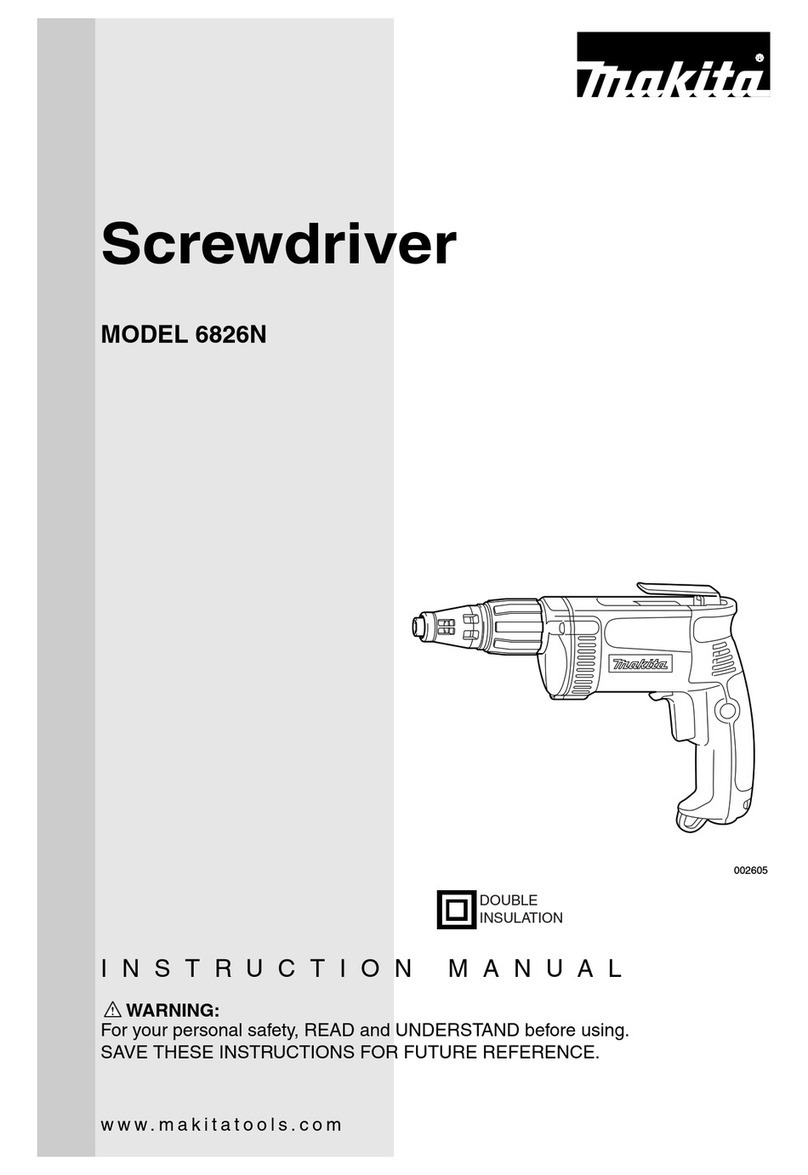EGAmaster 67194 User manual

MANUAL DE INSTRUCCIONES
OPERATING INSTRUCTIONS
ATORNILLADOR ELÉCTRICO
CORDLESS SCREWDRIVER
ESPAÑOL ............................... 2
ENGLISH................................ 8
GARANTIA / GUARANTEE... 15
COD. 67194

2
NORMAS DE SEGURIDAD GENERAL
ADVERTENCIA
lea todas las advertencias de seguridad e instrucciones. No hacerlo puede resultar en descargas
eléctricas, fuego y/o serios daños.
Guarde las instrucciones y advertencias para futuras referencias.
El término ‘herramienta eléctrica’ en las advertencias hace referencia a la herramienta tanto
enchufada como cuando funciona a través de una batería (sin cables).
1) ÁREA DE TRABAJO
a) Mantenga el área de trabajo limpia y bien iluminada. Las zonas desordenadas y oscuras son
más propensas a accidentes.
b) No opere con herramientas eléctricas en ambientes explosivos, es decir, en presencia de
líquidos inamables, gases o polvo. Las herramientas eléctricas hacen chispas que pueden hacer que el
polvo o los gases prendan fuego.
c) Mantenga a niños y viandantes lejos de la herramienta cuando esta se utilice. Las distracciones
pueden provocar la pérdida de control de la herramienta.
2) SEGURIDAD ELÉCTRICA
a) Los enchufes de las herramientas eléctricas deben encajar con la toma de corriente. No
modique el enchufe en ningún caso. No use adaptadores de enchufes con herramientas eléctricas
conectadas a tierra. Los enchufes que encajan con la toma de corriente y no han sido modicados
reducen el riesgo de descargas eléctricas.
b) Evite el contacto supercies conectadas a tierra tales como tuberías, radiadores,….. y
refrigeradoras. Hay un alto riesgo de descarga eléctrica si su cuerpo se encuentra en contacto con el
suelo.
c) No exponga las herramientas eléctricas a lluvia o condiciones de humedad. Si el agua entra en
una herramienta eléctrica se incrementa el riesgo de descarga eléctrica.
d) No maltrate el cable. No utilice el cable para llevar, estirar o desenchufar la herramienta eléctrica.
Mantén el cable lejos del calor, aceite, objetos alados y partes móviles. Los cables enredados o
dañados incrementan el riesgo de descarga eléctrica.
ESPAÑOL

3
e) Si utiliza una herramienta eléctrica en el exterior use un cable de extensión adecuado para el
uso en el exterior. El uso de cables de extensión adecuados para uso en el exterior reduce el riesgo de
descarga eléctrica.
Si el uso de herramientas eléctricas en lugares húmedos es inevitable, integre un dispositivo de
corriente residual (DCR). El uso de un RCD reduce el riesgo de descarga eléctrica.
3) SEGURIDAD PERSONAL
a) Manténgase alerta, vigile lo que hace y haga uso del sentido común cuando manipule una
herramienta eléctrica. No use una herramienta eléctrica si está bajo la inuencia de drogas, alcohol o
medicación o si está cansado. Un descuido a la hora de manipular la herramienta puede causar heridas
graves.
b) Use equipo de seguridad. Utilice siempre protección en los ojos. El uso apropiado de equipo
de seguridad, máscara antipolvo, calzado de seguridad, casco o protección para los oídos reducirá el
riesgo de heridas personales.
c) Evite accidentes asegurándose de que el interruptor está en la posición de apagado antes de
enchufarlo. Llevar herramientas eléctricas con el interruptor encendido puede acarrear accidentes.
d) Quite cualquier llave adjunta a la herramienta antes de encenderla. Una llave una parte adjunta a
la pieza rotatoria de la herramienta puede acarrear daños personales.
e) Mantenga el equilibrio y una buena posición cuando manipule la herramienta. Esto permite un
mejor control de la herramienta en situaciones inesperadas.
f) Vístase adecuadamente. No lleve ropa holgada o joyería. Mantenga su pelo, ropa y guantes
alejados de las piezas móviles. Ya que estos se pueden enganchar.
g) Si los dispositivos se utilizan para aspirar el polvo e instalaciones de recogida, asegúrese de que
estas están bien conectadas y utilizadas. El uso de estos dispositivos reduce el riesgo de peligro con el
polvo.
4) USO Y CUIDADO DE LA HERRAMIENTA
a) No fuerce la herramienta. Use la herramienta para su correcta aplicación. Esto hará que el
trabajo se mejor y más seguro.
b) No use la herramienta eléctrica si el interruptor no la enciende y apaga. Cualquier herramienta
que no pueda ser controlada con el interruptor es peligrosa y debe ser reparada.
c) Desconecte el enchufe de la fuente de alimentación antes de hacer ajustes, cambios de
accesorios o guardar la herramienta. Estas medidas de seguridad preventivas reducen el riesgo de que
la herramienta eléctrica se encienda accidentalmente.
d) Guarde la herramienta eléctrica fuera del alcance de los niños y no permita a alguien no
familiarizado con el uso o las instrucciones opere la herramienta. Las herramientas eléctricas son
peligrosas en manos de usuarios no experimentados.
e) Mantenga la herramienta. Busque malas alineaciones o conexiones entre sus piezas móviles,
rotura de las partes y cualquier condición que pueda afectar al manejo de la herramienta eléctrica. En
caso de estar dañada, repárela antes de utilizarla. Muchos accidentes son causados por herramientas
con un mal mantenimiento.
f) Mantén las herramientas limpias y aladas. Las herramientas en buen mantenimiento tienen
menos posibilidades de adherir y más fáciles de controlar.
g) Utilice la herramienta, los accesorios y sus piezas de acuerdo a estas instrucciones y de la
forma indicada para el uso particular de la herramienta, teniendo en cuenta las condiciones laborales y
el desempeño del trabajo. Utilizar la herramienta para operaciones para las que la herramienta no está
destinada puede ser peligroso.

4
5) ) USO Y CUIDADO DE LA BATERÍA
a) Recargar solo con el cargador especíco por el fabricante. Un cargador adecuado a un tipo de
batería puede causar riesgo de incendio si se usa para otra batería.
b) Use la herramienta solo con las baterías designadas especícamente. El uso de otras baterías
puede crear riesgo de lesión o fuego.
c) Cuando las baterías no están en uso, manténgalas alejadas de otros objetos de metal, clips,
monedas, llaves, clavos, tornillos u otros objetos pequeños metálicos que puedan crear una conexión de
una terminal a otra. Unir las terminales de la batería puede causar quemaduras o incendios.
d) Bajo condiciones abusivas, el líquido de la batería puede ser eyectado, evite el contacto. Si se
produce un contacto accidental, lave con agua. Si el líquido entra en contacto con los ojos, además
busque ayuda médica. El líquido eyectado de la batería puede causar irritación o quemaduras.
6) SERVICIO
En caso de necesitar ser reparada, acuda a un profesional y utilice solo piezas idénticas. Esto
asegura el mantenimiento de la seguridad de la herramienta eléctrica.
ADVERTENCIAS ESPECIALES DE SEGURIDAD
Incluso cuando se utiliza la herramienta adecuadamente es imposible eliminar todos los riesgos.
Se pueden dar las siguientes lesiones en relación a la construcción y diseño de la herramienta:
- Daños en los pulmones si no se usa la máscara antipolvo.
- Lesiones auditivas si no se utiliza la protección adecuada.
- Daños de salud como consecuencia de las vibraciones emitidas por el uso de la herramienta
durante un largo período de tiempo o a causa de un mantenimiento o manejo inadecuado.
– Sujete la herramienta en supercies aisladas de sujeción, cuando opere en un lugar donde
el tornillo pueda estar en contacto con cables internos o el suyo propio. Tornillos en contacto
con cableado en funcionamiento pueden exponer partes metálicas de la herramienta durante su
funcionamiento y dar una descarga eléctrica al operador.
MEDIDAS DE SEGURIDAD PARA BATERÍA Y CARGADOR RECARGABLE
Use únicamente la batería proporcionada con la herramienta o una batería recargable y el cargador
proporcionado. Enchufe la batería a 230v. Proteja la batería y el cargador de esta de la humedad. No
opere la batería en el exterior. Cuando no la utilice y antes de su limpieza y mantenimiento, desconecte
el cargador de la batería de la fuente de alimentación. Tenga especial cuidado con la batería. Evite
dejarla sobre una supercie dura y ponerla bajo presión o cualquier tipo de estrés mecánico. Mantenga
la batería alejada de calor y frío extremos. No intente reparar la batería ni el cargador de esta. Si alguna
pieza es defectuosa, haga que sean reparadas por un técnico o envíelas a nuestro servicio técnico. Solo
cargue la batería a una temperatura ambiente de entre 10ºC y 40ºC. La batería cargada se podrá utilizar
para hacer funcionar la máquina a temperaturas de entre 0ºC y 50ºC. Cuando no la utilice, guarde la
batería en un lugar seco a una temperatura de entre 10ºC y 30º.
¡Importante! ¡Peligro! No provoque un cortocircuito o exponga la batería a la humedad. No la
almacene con piezas metálicas que puedan provocar un cortocircuito en los contactos. La batería podría
recalentarse, quemarse o explotar.

5
De entrar en contacto con ácido, uidos o sustancias internas similares contenidas en la batería,
lávese con abundante agua. Si estas sustancias entran en contacto con los ojos, aclare con abundante
agua y vaya al médico inmediatamente.
No tire la batería portátil al agua o al fuego. Puede explotar. La batería recargable no debe ser
desechada en la basura de uso doméstico, tanto si ha sido usada como si no. Debe ser desechada en
los puntos locales de recogida de baterías conforme a las regulaciones sobre baterías o devueltas bajo
la etiqueta “batería usada”.
DATOS TÉCNICOS
Max.
N.m rpm V V Batería
1/4” 3 N.m 200 110-240V
(50-60Hz) 3,6 DC Li-ion 950 1
Autonomía en uso 50 min
Tiempo de carga 4 h
Reversible sí
Puntas incluidas
2x0,4 / 3x0,5 / 5x0,8 / 6x1,2
PH0 / PH1 / PH2
PZ0 / PZ1 / PZ2
HEX3 / HEX4 / HEX5
Brocas incluídas HSS Ø1,5mm - HSS Ø3mm
CARACTERÍSTICAS DEL PRODUCTO
INSTRUCCIONES DE FUNCIONAMIENTO
Botón Izquierda/Derecha
Conguración de torsión
Botón de bloqueo
Interruptor ON/OFF
Luz LED
Conector de alimentación

6
FUNCIONAMIENTO INICIAL
CARGAR LA MÁQUINA
La máquina ha de ser cargada antes de su primer uso. Cargue la máquina una vez esté
completamente descargada, es decir cuando su rendimiento se reduzca claramente. De no ser así,
puede que la máquina no alcance su capacidad máxima en la próxima carga.
¡Importante! Use solo el cargador proporcionado para cargar la batería. En primer lugar inserte la
máquina en el hueco de carga y esta comenzará a cargarse automáticamente.
Deje de cargar la batería después de alrededor de 5 horas. Desconecte siempre la batería del
cargador.
INSERTAR LAS PIEZAS DE LA HERRAMIENTA
¡Importante! Aparte siempre la máquina cuando cambie la parte de la tuerca para evitar que la
máquina se encienda por accidente. La máquina tiene un porta-puntas de cambio rápido, simplemente
gire el cuello el cuello tanto para insertar como para extraer la punta que esté utilizando. Deslice el
cuello hace atrás para bloquear su punta.
INTERRUPTOR ON/OFF
Usa el interruptor On/O para encender la máquina y manténgala sujeta si se usa de forma continua.
Para apagarla suelta el interruptor On/O.
LUZ
La máquina tiene incorporada una luz para su uso en lugares oscuros. Deslice el interruptor para
encenderlo o apagarlo tal y como se requiere cuando se necesite. Apáguelo cuando no se necesite para
ahorrar batería.
FUNCIONAMIENTO PARA OPERAR
Use solo piezas que puedan ajustarse a la punta de forma segura, que hayan sido diseñadas para
ello.
Antes de utilizar la máquina asegúrese de que el tornillo está insertada correctamente. Evite los
tornillos excesivamente apretados, de no ser así se puede dañar la cabeza del tornillo o incluso
laminarse.
INSERCIÓN DEL TORNILLO
Ajusta la dirección de rotación del atornillador según las manecillas del reloj. Inserta la pieza en la
ranura de la cabeza del tornillo, de forma que esta quede perpendicular a la cabeza del tornillo. De no
hacerlo así la pieza rotatoria o la cabeza del tornillo pueden dañarse. Presiona la pieza contra el tornillo
aplicando una presión constante mientras se gire el tornillo. Cuando el tornillo está completamente
atornillado, sujete rmemente la máquina y suelte el interruptor On/O o el tornillo o la cabeza de este
podría dañarse. Si el interruptor On/O no se suelta inmediatamente, la torsión podría dañar también la
pieza giratoria o el atornillador.

7
RETIRADA DEL TORNILLO
Ajusta la dirección de rotación del atornillador de forma que gire en la dirección opuesta a la de las
manecillas del reloj. Inserta la pieza en la ranura de la cabeza del tornillo, de forma que esta quede
perpendicular a la cabeza del tornillo. De no hacerlo así la pieza rotatoria o la cabeza del tornillo pueden
dañarse. Presiona la pieza contra el tornillo aplicando una presión constante mientras se saque el
tornillo.
MANTENIMIENTO Y LIMPIEZA
¡Atención! Quite siempre la batería antes de llevar a cabo cualquier trabajo con la máquina.
Para limpiarlo use siempre una toalla seca o húmeda, no mojada. Muchos agentes químicos
contienen sustancias químicas que pueden causar daños en las partes de plástico de la máquina. Por
tanto, no use ninguna sustancia de limpieza fuerte o inamable como el petróleo, disolvente, aguarrás u
otros agentes de limpieza similares. Mantenga los agujeros de ventilación siempre libres de polvo para
evitar que la herramienta se recaliente.
NOTAS
IMPORTANTE!
El fabricante no se responsabiliza de los daños o mal funcionamiento del aparato, en caso de que no
se use correctamente o se haya utilizado para trabajos para los que no esté diseñado.
De acuerdo con la Directiva de Residuos de Aparatos Eléctricos y Electrónicos (RAEE), estos
deben ser recogidos y dispuestos por separado. Si usted tiene que tirar, por favor, no use la basura
habitual. Por favor, póngase en contacto con su distribuidor para el reciclaje de forma gratuita.
GARANTIA
Esta garantía no cubre aquellas piezas que por su uso normal tienen un desgaste.
Nota: para obtener la validez de la garantía, es absolutamente imprescindible que complete y
remita al fabricante el documento de “CERTIFICADO DE GARANTIA”, dentro de los siete dias a
partir de la fecha de compra.

8
GENERAL SAFETY RULES
WARNING
Read all safety warnings and all instructions Failure to follow all warnings and instructions may result
in electric shock, re and/or serious injury.
Save all warnings and instructions for future reference
The term “power tool” in the warnings refer to your mains operated (corded) power tool or battery
operated (cordless) power tool.
1) WORK AREA
a) Keep work area clean and well lit. Cluttered and dark areas invite accidents.
b) Do not operate power tools in explosive atmospheres, such as in the presence of ammable
liquids, gases or dust. Power tools create sparks which may ignite the dust or fumes.
c) Keep children and bystanders away while operating a power tool. Distractions can cause you to
lose control.
2) ELECTRICAL SAFETY
a) Power tool plugs must match the outlet. Never modify the plug in any way. Do not use any adapter
plugs with earthed (grounded) power tools. Unmodied plugs and matching outlets will reduce risk of
electric shock.
b) Avoid body contact with earthed or grounded surfaces such as pipes, radiators, ranges and
refrigerators. There is an increased risk of electric shock if your body is earthed or grounded.
c) Do not expose power tools to rain or wet conditions. Water entering a power tool will increase the
risk of electric shock.
d) Do not abuse the cord. Never use the cord for carrying, pulling or unplugging the power tool.
Keep cord away from heat, oil, sharp edges or moving parts. Damaged or entangled cords increase
the risk of electric shock.
e) When operating a power tool outdoors, use an extension cord suitable for outdoor use. Use of a
cord suitable for outdoor use reduces the risk of electric shock.
If operating a power tools in a damp location is unavoidable, use a residual current device (RCD)
protected supply. Use of an RCD reduces the risk of electric shock.
ENGLISH

9
3) PERSONAL SAFETY
a) Stay alert, watch what you are doing and use common sense when operating a power tool. Do not
use a power tool while you are tired or under the inuence of drugs, alcohol or medication. A moment of
inattention while operating power tools may result in serious personal injury.
b) Use safety equipment. Always wear eye protection. Safety equipment such as dust mask, non-skid
safety shoes, hard hat, or hearing protection used for appropriate conditions will reduce personal injuries.
c) Avoid accidental starting. Ensure the switch is in the o position before plugging in. Carrying power
tools with your nger on the switch or plugging in power tools that have the switch on invites accidents.
d) Remove any adjusting key or wrench before turning the power tool on. A wrench or a key left
attached to a rotating part of the power tool may result in personal injury.
e) Do not overreach. Keep proper footing and balance at all times. This enables better control of the
power tool in unexpected situations.
f) Dress properly. Do not wear loose clothing or jewellery. Keep your hair, clothing and gloves away
from moving parts. Loose clothes, jewellery or long hair can be caught in moving parts.
g) If devices are provided for the connection of dust extraction and collection facilities, ensure these
are connected and properly used. Use of these devices can reduce dust related hazards.
4) POWER TOOL USE AND CARE
a) Do not force the power tool. Use the correct power tool for your application. The correct power tool
will do the job better and safer at the rate for which it was designed.
b) Do not use the power tool if the switch does not turn it on and o. Any power tool that cannot be
controlled with the switch is dangerous and must be repaired.
c) Disconnect the plug from the power source before making any adjustments, changing accessories,
or storing power tools. Such preventive safety measures reduce the risk of starting the power tool
accidentally.
d) Store idle power tools out of the reach of children and do not allow persons unfamiliar with the
power tool or these instructions to operate the power tool. Power tools are dangerous in the hands of
untrained users.
e) Maintain power tools. Check for misalignment or binding of moving parts, breakage of parts and
any other condition that may aect the power tools operation. If damaged, have the power tool repaired
before use. Many accidents are caused by poorly maintained power tools.
f) ) Keep cutting tools sharp and clean. Properly maintained cutting tools with sharp cutting edges are
less likely to bind and are easier to control.
g) Use the power tool, accessories and tool bits etc., in accordance with these instructions and in the
manner intended for the particular type of power tool, taking into account the working conditions and the
work to be performed.
Use of the power tool for operations dierent from intended could result in a hazardous situation.
5) BATTERY TOOL USE AND CARE
a) Recharge only with the charger specied by the manufacturer. A charter that is suitable for one
type of battery pack may create a risk of re when used with another battery pack.
b) Use power tools only with specically designated battery packs. Use of any other battery packs
may create a risk of injury and re.
c) When battery pack is not in use, keep it away from other metal objects, lie paperclips, coins, keys,
nails, screws or other small metal objects, that can make a connection from one terminal to another.
Shorting the battery terminals together may cause burns or a re.
d) Under abusive conditions, liquid may be ejected from the battery; avoid contact. If contact
accidentally occurs, ush with water. If liquid contacts eyes, additionally seek medical help. Liquid
ejected form the battery may cause irritation or burns.

10
6) SERVICE
Have your power tool serviced by a qualied repair person using only identical replacement parts.
This will ensure that the safety of the power tool is maintained.
SPECIAL SAFETY WARNINGS FOR SCREWDRIVER
Even when the power tool is used as prescribed it is not possible to eliminate all residual risk factors.
The following hazards may arise in connection with the power tool’s construction and design:
- Damage to lungs if an eective dust mask is not worn.
- Damage to hearing if eective hearing protection is not worn.
- Damages to health resulting from vibration emission if the power tool is being used over longer
period of time or not adequately managed and properly maintained.
Hold power tool by insulated gripping surfaces, when performing an operation where the
fastener may contact hidden wiring or its own cord. Fasteners contacting a “live” wire may make
exposed metal parts of the power tool “live” and could give the operator an electric shock.
SAFETY ADVICE FOR RECHARGEABLE BATTERY AND CHARGER
Use only the battery provided with the tools or a replacement rechargeable battery from the
manufacturer and the provided charger. Only plug the battery charger in at 110-240V (50-60Hz) mains.
Protect battery and battery charger from humidity. Do not operate the battery charger outdoors. When
not in use and before cleaning and servicing, disconnect the battery charger from the power supply. Take
special care of the battery. Avoid dropping it onto any hard surface and do not subject it to pressure or
any other form of mechanical stress. Keep the battery away from extreme heat and cold. Do not open
or attempt to repair the battery or the battery charger. If any parts are defective, have them repaired by
a qualied technician or send them to our service department for repair. Only charge the battery at an
ambient (surrounding air) temperature between 10ºC and 40ºC. A charged battery can be used to power
the machine under ambient temperature conditions between 0ºC and 50ºC.When not in use, store the
battery in a dry place between 10ºC and 30ºC.
Important! Danger!
Never short-circuit the battery or expose it to moisture. Do not store it together with any metal parts
which could short-circuit the contacts. The battery could overheat, start burning or explode.
If any person comes into contact with acid or similar internal uids or substances contained
in the battery, wash o these substances immediately with plenty of water. If these substances
make contact with the eyes, rinse with plenty of water and visit a doctor immediately.
Do not place the rechargeable battery into re or water. It can explode. The Rechargeable Battery
should not be discarded to domestic refuse, regardless of whether used or unused. You should return
it to a local battery collection point in accordance with Battery Regulations or return them to us suitably
marked “Used Battery”.

11
TECHNICAL DATA
Max.
N.m rpm V V Battery
1/4” 3 N.m 200 110-240V
(50-60Hz) 3,6 DC Li-ion 950 1
Operating time 50 min
Charge 4 h
Reversible yes
Included bits
2x0,4 / 3x0,5 / 5x0,8 / 6x1,2
PH0 / PH1 / PH2
PZ0 / PZ1 / PZ2
HEX3 / HEX4 / HEX5
Included drills HSS Ø1,5mm - HSS Ø3mm
PRODUCT FEATURES
OPERATION INSTRUCTIONS
Left/Right button
Torque Setting
Lock button
On/o triger
LED working ligth
DC Jack

12
INITIAL OPERATION
CHARGING THE MACHINE
The machine must be charged before the rst use. Only recharge the machine once it is has been
fully discharged, i.e. the performance clearly decreases. Otherwise the machine may not achieve its full
capacity at the subsequent charge.
Important! Only use the provided battery charger for charging the battery. First place the machine
into the charging slot ,Charging starts automatically.
Remove the machine from the charge after about 5 hours. Always disconnect the charger from the
charger.
INSERTING TOOL BITS
Important! Always remove the machine before you change the screw bit to avoid unintentional
starting of the machine. The machine has a quick release chuck feature, simply side the collar forward to
either insert of extract the tip you are using. Let the collar slide back to lock in you tip.
ON/OFF TRIGGER
Use the On/O trigger to start the machine and keep holding it for continuous operation.
To switch the machine o, release the On/O trigger
LIGHT
The machine has a built in light so as to perform tasks in dark environments. Simply slide the switch
on and o as required when needed. Turn o when not needed so as to save battery life.
OPERATION FOR WORKING
Only use tool bits which can be securely fastened in the chuck and for which the bits has been
designed.
Before using the machine check whether the screw-bit is inserted correctly. Avoid over-tightening
screws, otherwise the screw head may be damaged or stripping of the threads may occur.
SCREW INSERTION
Set the direction of rotation of the drill to the clockwise direction. Insert the screw-bit into the slot in
the head of the screw. Hold the screw bit perpendicular to the head of the screw, otherwise the screw or
the screw head may be damaged. Press the screw bit against the screw with a constant pressure while
driving in the screw.
When the screw is completely screwed in, hold the machine rmly and release the On/O trigger,
otherwise the screw or the screw head may be damaged. If the On/O trigger is not released
immediately a high torque could also damage the drill bit or the drill.

13
SCREW REMOVAL
Set the direction of rotation of the drill to the anticlockwise direction. Insert the screw-bit into the slot
in the head of the screw. Hold the screw-bit perpendicular to the head of the screw, otherwise the screw
or the screw head may be damaged. Press the screw bit against the screw with a constant pressure
while removing the screw.
MAINTENANCE AND CLEANING
Attention! Always remove the battery before carrying out any work on the machine.
To clean, always use a dry or moist, but not wet, towel. Many cleaning agents contain chemical
substances which may cause damage to the plastic parts of the machine. Therefore do not use any
strong or inammable cleaners such as petrol, paint thinner, turpentine or similar cleaning agents.
Always keep air ventilation holes free of dust deposits to prevent overheating.
NOTES
IMPORTANT!
The maker will not take responsibility for damage or malfunction as a result of the machine being
incorrectly used or, applied for a purpose for which it was not intended.
According to Waste Electrical and Electronic Equipment directive (WEEE), these ones must be
collected and arranged separately. If you have to throw them out, please, do not use the usual rubbish.
Please, contact your distributor for free recycling.
GUARANTEE
The maker guarantees to the machine owner 12 months against any manifacture defect.
This guaranteee do not cover the parts wich are consumables.
Note: to apply the guarantee its necesary to send the “GUARANTEE CERTIFICATE” duly lled
within one week after purchased the machine to the maker.





Table of contents
Languages:
Other EGAmaster Power Screwdriver manuals

